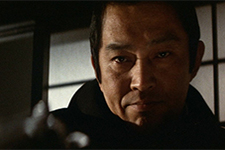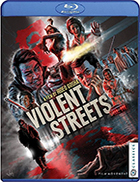Violent Streets (Bôryoku gai)
|  Set in Tokyo’s brutal criminal underworld, Violent Streets (Bôryoku gai) was the first of only three films that director Hideo Gosha made during his 30-year career that were set in the contemporary era. The rest of his nearly two dozen films were samurai and period melodramas, including his eight previous films beginning with Three Outlaw Samurai (Sanbiki no samurai, 1964). A veteran of both radio and television, Gosha was a unique, multi-talented, and unconventional filmmaker who straddled the traditions of mid-20th-century Japanese cinema as embodied by Akira Kurosawa and the bold, subversive strokes of the emerging Japanese New Wave. His worked in traditional territory, but always made the material his own. While not one of Gosha’s best works, Violent Streets is nevertheless an intriguing example of the shift in the yakuza (gangster) genre, which Japanese film expert Jasper Sharp has described as moving from a more ritualized portrait that focused on group loyalty and codes of honor (ninkyô eiga) toward a grittier, more realistic treatment (jitsuroku, which means “true record”). Gosha had directed one of the former in The Wolves (Shussho iwai, 1971), which was set in the late 1920s and was typical in its narrative about a gangster recently released from prison and looking to restore his honor, while Violent Streets is very much the latter, with its appeals to realism embedded not only in its intense aesthetic and heightened violence, but also by the fact that the protagonist is played by Noboru Andô, a former yakuza in real life who dissolved his gang (which roamed Tokyo’s Shibuya ward) and became an actor after serving a six-year prison sentence for ordering a rival’s murder (the long scar stretching from the corner of his mouth to his left ear is a tangible physical reminder of his former violent life). Andô, who had also starred in The Wolves, plays Egawa, a former yakuza family head who has since left the criminal life and now manages a Spanish-themed nightclub in Tokyo’s high-end Ginza district that was gifted to him by Gohara (Shigeji Takada), for whom his family used to work. Gohara has spent the past decade trying to turn his criminal enterprise into a legitimate business operation, and he wants Egawa to return the night club, which he refuses to do. Despite the fact that he has the implacable flintiness of a Japanese Charles Bronson, Egawa is a Humphrey Bogart-style romantic who is still nursing the heartbreak of losing his girlfriend to Gohara. He is sexually involved with Akiko (Maki Kawamura), an alcoholic who works at his night club (whether she was already an embittered inebriate or was driven to drink and depression by Egawa’s emotional coldness is left open-ended). To make matters worse, a gang war is being purposefully started by some of Egawa’s former gang members via the kidnapping of Minami, a pop singer (Minami Nakatsugawa) who is backed by Gohara. The broad strokes of the screenplay, which was penned by exploitation scribes Masahiro Kakefuda and Nobuaki Nakajima (Terrifying Girls’ High School: Animal Courage , A Haunted Turkish Bath House) from an idea by Gosha, are fairly typical and not terribly surprising or revelatory. The whole enterprise has an existential angst and a clear trajectory leading to tragedy, and where it really works is in the individual set-pieces, which Gosha stages with such vigor and flair that you can’t help but be drawn into the pulpy madness. One of the standout sequences takes place inside a large henhouse, with bullets and feathers flying in equal measure. Another sequence, which involves the killing of a rival gangster, takes place at a muddy construction site littered with naked mannequins, whose uncanny presence has no narrative justification outside of the visual discomfort it creates. Throughout Violent Streets, Gosha employs the same highly stylized interplay with regular and slow motion that Kurosawa first employed in Seven Samurai (1954) and Arthur Penn and Sam Peckinpah refined and amplified in Bonnie and Clyde (1967) and The Wild Bunch (1969), respectively. By the mid-1970s, that kind of stylized violence-ballet was already familiar to genre audiences, but Gosha still gives it some added kick with his sheer viciousness. One of the film’s assassins is a trans woman (Madame Joy) who favors a straight razor blade, which is surely one of the least effective means of taking out a target, but certainly offers some really nasty bloodshed in the process. Such is typical of Gosha’s aesthetic, which mixes the gritty and the lurid in equal measure.
Copyright © 2023 James Kendrick Thoughts? E-mail James Kendrick All images copyright © Film Movement Classics | |||||||||||||||||||||||||||||
Overall Rating: 

 (2.5)
(2.5)


